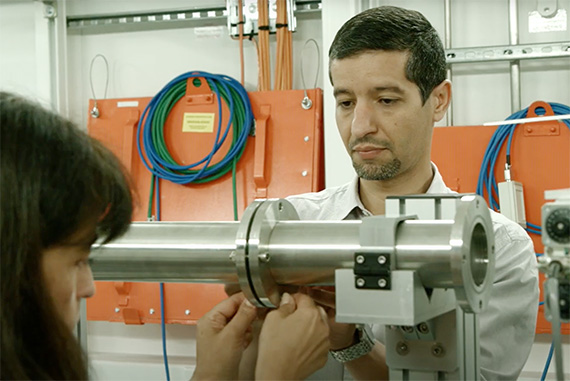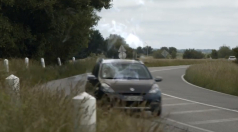Over 40 billion tons of CO2 are emitted every year due to human activities. What can we do with this waste?
In Nature, plants capture CO2 and transform it into plant material (biomass) thanks to solar energy. It’s photosynthesis.
At the Institut de Chimie Moléculaire et des Matériaux (Orsay), the scientific team called « artificial photosynthesis » is inspired by this natural phenomenon in order to transform CO2, not into biomass but into clean fuels such as methanol or methane.
In 2018 this team came to SOLEIL, at the ROCK beamline, to find out what are the best catalysts of the chemical transformation of CO2, that is to say the compounds that will achieve this artificial photosynthesis quickly and efficiently. As part of our series 'Next Chapter,' we reconnected with the scientists filmed in 2018 and asked them how their research has progressed since then.

Zakaria Halime (CNRS, ICMMO) here filmed in 2018 on the ROCK beamline preparing his experiment with the help of Stéphanie Belin, left, scientist on the beamline.
Eliminating the CO2 that saturates our atmosphere... An ecological Holy Grail that many scientists are persistently striving to reach. This is the case for Zakaria Halime, a chemist who is exploring every possible way to transform undesirable carbon dioxide—particularly into CO, carbon monoxide. While this gas is feared when it leaks from our boilers, it is actually a key component in a wide range of industries. Hundreds of thousands of tons of it are produced annually to manufacture methane, methanol, hydrocarbons, or even acetic acid.
Zakaria Halime has valuable allies to break down the CO2 molecule: catalysts—such as iron porphyrins—that enhance and accelerate the chemical reaction. In 2018, alongside Benedikt Lassalle, a scientist at the synchrotron SOLEIL, he developed a new spectroscopy method to observe in real time, using X-rays, the reduction of CO2 into CO. This method relies on an electrochemical cell placed on the ROCK beamline at SOLEIL. The method proved effective, resulting in a first publication (1).
Subsequently, Zakaria made the catalytic system that breaks down CO2 even more flexible. The chemist is now able to fine-tune the very structure of the catalyst to give it the desired qualities for a specific application. For instance, to achieve a more energy-efficient reaction, a faster reaction, or even a reaction that remains effective when CO2 is present in low concentrations. In short, a kind of "Swiss army knife" catalyst that adapts to various objectives (2).
Once again, with Benedikt Lassalle, Zakaria tested a new approach using the LUCIA beamline. Instead of allowing the reaction to occur in an organic solvent, as is usually the case, they deposited the catalyst on a modified electrode. The CO2 was then reduced in water, quite simply. This process presents highly interesting advantages for industry: the final product can be collected in water instead of requiring extraction from an organic mixture, and the reaction can be scaled up (3).
However, the relentless quest for effective methods to convert CO2 into CO can interest sectors beyond energy, such as the pharmaceutical industry. During the validation process of a new drug, it is common to "radio-label" it—introducing a slightly radioactive marker to track the distribution of the active molecule in the body. Eighty percent of drugs go through this little-known stage before being marketed. In 2023, Zakaria Halime proposed an innovative concept for radio-labeling. First, by using CO2 in which the carbon is slightly radioactive (either "carbon-13" or "carbon-14" instead of the most abundant "carbon-12"). Then, by reducing this CO2 into CO while preserving its radioactivity. Finally, by inserting this CO into the active molecule, thus producing a "labeled" drug. This original idea resulted in a publication in the prestigious journal Nature (4).
Amidst this rich and complex nebula of chemical reactions, Zakaria anticipates once again turning to the synchrotron in the future: "Real-time X-ray spectroscopy is an important tool. I'm in almost constant dialogue with Benedikt Lassalle, and that won’t be ending anytime soon!"

